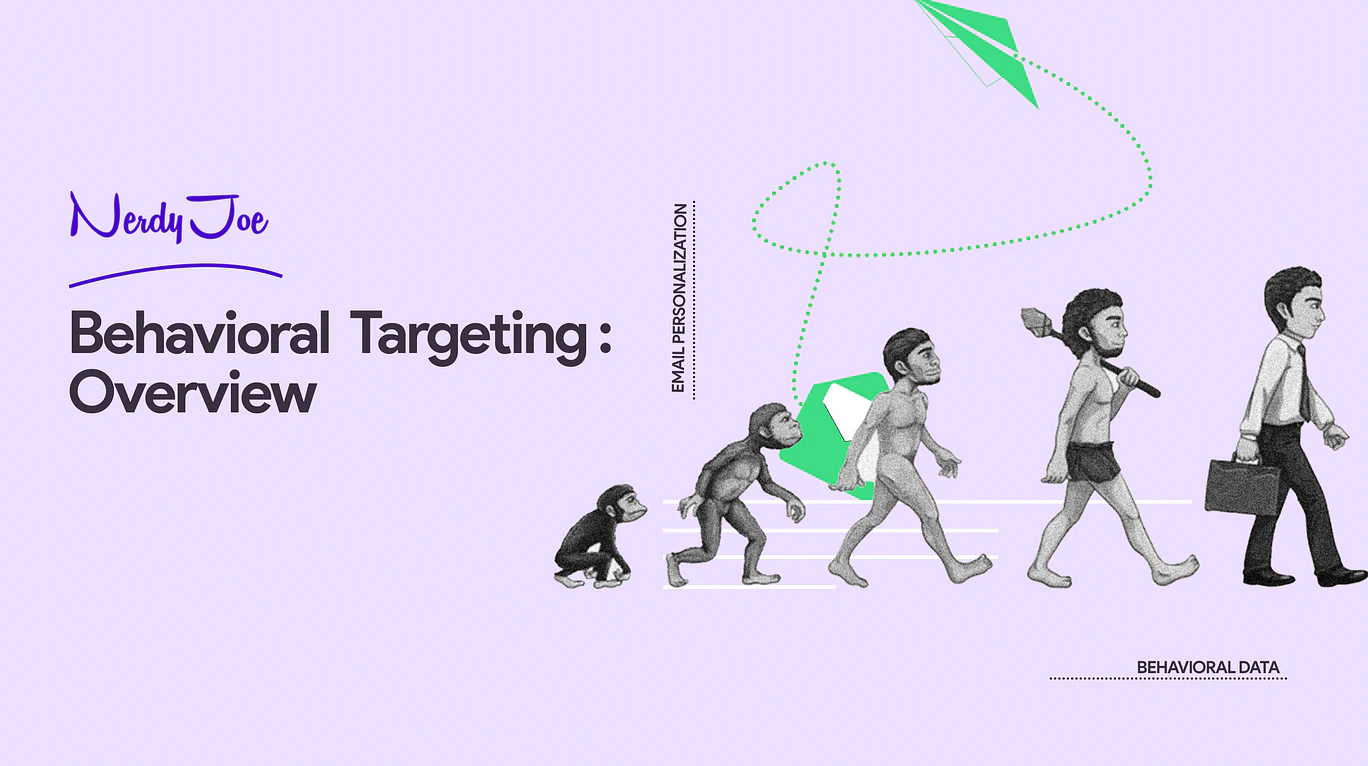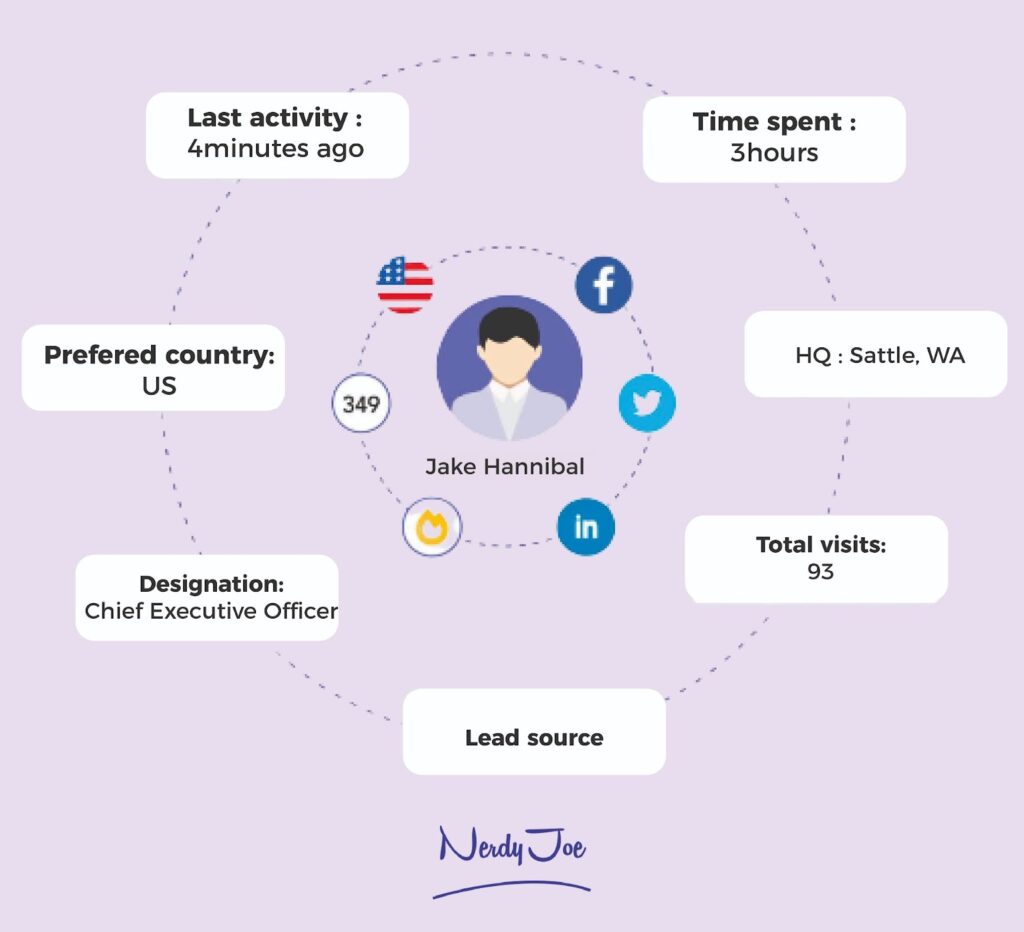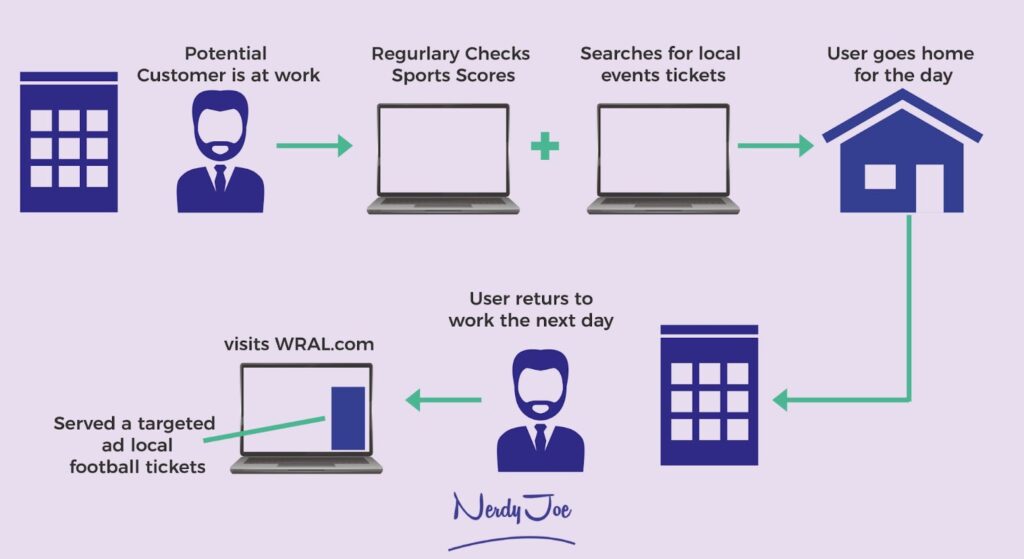
The competition is fierce in B2B and B2C.
So, not properly identifying your audience needs and targeting consumers with unrelated ads, emails, generic messages and calls — that they will most likely ignore — will get you nothing.
Marketing itself has become a game of super-personalized, contextual targeting and providing prospects with products they’ll genuinely benefit from. You can’t afford not to be relevant and specific.
That’s why you need to engage in behavioral targeting.
In a nutshell, behavioral targeting involves collecting data on consumer behavior and using it to segment your audience and craft super-personalized marketing materials and communications that align with your targets and suit their interests.
According to Marketo, behavioral targeting can help increase email opens by 56.68% and Click-throughs by 147%.
Moreover, according to Monetate, 86% of companies with high ROI spend at least 21% of their budget on personalization.
But, how do you approach behavioral targeting? How do you plan and implement effective targeting based on user behavior and interest?
That is why you have this article. Here, you will learn the essential details you need to know about behavioral targeting.
What is Behavioral Targeting?
Behavioral targeting is a marketing method that allows marketers to send tailored marketing messages or ads to web visitors based on their web browsing behaviors and specified interests.
This form of targeting mostly relies on data gathered from users’ behaviors such as past purchases, previously visited websites, search terms, and more.
For instance, if a consumer spends twenty minutes browsing email marketing tools, googling prices of software, and reading blogs relating to email marketing on your site, you can create a behavioral targeting strategy where you start by analyzing these data and send them targeted ads about email marketing tools to the consumer when next they visit your website.
Types of Behavioral Targeting
There are essentially two types of behavioral targeting that marketers can implement: onsite behavioral targeting and network behavioral targeting.
1 – Onsite behavioral targeting
Onsite behavioral targeting occurs within a particular site. Here, brands track site visits, clicks, user journey, interests and actions taken by a specific customer, or any other relevant data about the user’s behavior on their website and recommend content, solutions or products accordingly.

The process is generally automated and tracks anything like activities, interests, and other relevant attributes. The recommendations can be anything like downloading a brochure, signing up for a newsletter, sending them personalized ads, urging them to buy a specific product, getting them to visit other pages and much more.
They are often displayed on the home page or product page.
2 – Network behavioral targeting
In network behavioral targeting involves collecting user data across various sites on the Internet, using the data to gather insights and sending marketing messages and ads that will best resonate with them.

Although this data doesn’t include private information such as people’s names, telephone numbers, or email addresses, it involves obtaining device-identifying information (the IP and MAC addresses), cookies, and other relevant information.
Then, an algorithm is used to process the data and segment users. Based on the data, the algorithm can determine the person’s gender, typical journey on the internet, interest, purchase decisions, and more.
For instance, if a user is seen searching for anti-aging skincare products, a reasonable guess opines that the user is a female.
Such information enables the marketer to craft and display relevant ads or emails for the audience. Such information enables the marketer to craft customized ads or emails for the audience.
Understanding Behavioral Email Targeting
In email marketing, behavioral advertising amounts to sending targeted, automated emails to your subscribers based on the interactions they have had with your company across various channels — your website, social media, email, and more.
Unlike traditional email campaigns or online advertising that involve sending content (ebooks, videos, white papers, infographics, offers, and more) to your subscribers out of the blue, email behavioral targeting work by adopting a user-focused approach.
In other words, it is the level of engagement (or lack thereof) of your email subscribers and web visitors that determine the kind of email you should send.
This is not a decision a marketer can make based on their gut feeling as it heavily depends on your audience.
For instance, you can implement behavioral targeting emails after your customers:
- Submit a form to download valuable content on your website. You can provide content like videos, case studies, infographics, etc.
- Abandon some items in the shopping cart without checking out. You can send them an email to remind them while offering some incentives – a small discount, letting them know about the limited stock, and more
- View specific content on your website. For example, if they spend some time going through the FAQ section, you can set up a behaviorally targeted email to check whether they have a question
In behavioral email targeting, your customer is the focus, and not your brand or its product. Since they are choosing the kind of content to interact with on your website, you set up emails on those choices to keep them engaged and service other benefits.
Why is behavioral targeting important for email marketers?
Behavioral targeting is a reliable marketing method that offers lots of benefits not only to the marketers but to the consumers. Here are some of the benefits you can get from developing campaigns based on users’ behaviors.
1 – Increased user engagement
Non-targeted emails are most likely to be generic and feel irrelevant to customers—which may cause them to diminish their level of interactions with your brand.
However, behavioral targeting prevents such scenarios from happening by allowing you to contact your audience based on previous interactions they have had with your site or any other digital assets related to your company.
It allows you to create emails that appeal to your audience and suit their interests. In turn, they are more likely to click through and learn more about the products and services you offer. This engages the customer and prompts them to take further action.
2 – Enables informed decisions
Instead of testing various marketing methods across different channels or using hypotheses and guesses to create your customer’s journey, behavioral targeting gives you facts topped with contextual data to determine what your audience has done.
This gives you insights on how to effectively reach and convert them with a targeting method and offers that resonate with them.
3 – Creating customized offers
Behavioral targeting enables marketers to create customized offers for their audience targeting. For example, by understanding the user’s purchase history, you can understand their needs and formulate relevant deals and offers that align their needs and goals.
For instance, if a customer leaves an item in the cart without checking out, you can send an email that reminds them of the product. Or better, you can wrap the product into a deal that benefits them better and win them over.
4 – High conversion rates
The end goal of any website is to have conversions. By conversion, this doesn’t only mean sales. It could be getting your prospect to sign up for your email list, download a brochure, complete contact forms, or request for information. It is any action that gets you closer to the desired goal.
Using behavioral data for contextual advertising enables you to reach people trying to perform these actions. You can see their interactions and craft an effective emails and develop targeting methods that reaches and converts them.
For instance, if you notice that a new visitor is going through your blogs and videos on your website about a particular topic, you can create contextual advertising campaigns that offer that they sign up on your mailing list to educate them about that content.
When you send relevant, interest-based offers and emails to your prospects, they are more likely to convert.
5 – Increased ROI
Traditional email marketing strategies encourage marketers to cast nets based on their instinct, guesses, and all—without yielding any results.
You could likely get lost in the seas of competitors without reaching the right audience.
Besides, you could waste resources by reaching the wrong audience who aren’t interested in what you offer.
But with behavioral marketing, you can stand out from your competitors by identifying and reaching people who are interested in your products.
Based on their activities and engagement with your marketing materials, you can provide relevant information that engages them and prompts them to take action.
The more clicks, the higher the chance of selling. This equates to profit that impacts your ROI.
How To Perform Behavioral Targeting in Three Different Steps
Now that you understand what behavioral targeting means, its importance, and its types, then you need to know how to implement it for your business. Here is a three-step framework you can use to implement behavioral targeting for your business.
1 – Collection and analysis of data
The first step in executing a behavioral email targeting strategy is to study the activities of your audience. After all, you can’t craft and send behavior-driven emails if you don’t know your users’ behaviors.
To do this, you can obtain useful data from different sources—social media platforms, mobile apps, emails, websites, heat mapping (such as HotJar), CRM systems, surveys, or even webinars—used to engage their audience. The data often consists of an individual’s:
- User Login Information (for registered users)
- Demographics
- IP address and Geolocation
- Session duration
- Pages visited on the site
- Clicks
- Previous purchases
- Interaction with elements of the site
- Website visited
- Searches within the site
- Content read
Although gathering these data manually seems simple, you can utilize tracking pixels or third-party cookies on your sites and web pages to do the task with ease.
Once the data is collected, it can be analyzed and used to segment the audience.
You can also use a data management platform to perform the task. These platforms not only allow you to obtain information about your audience, but also store, analyze, and use it for future behavioral targeting purposes.
2 – Segmentation
In this stage, visitors are categorized into different segments based on their behaviors. In other words, the marketer utilizes the collected data to distribute consumers into various categories to make the targeting of messages or ads easier.
For instance, you can categorize people who buy shoes on one side, whereas you can categorize people who buy shirts on another end.
3 – Application of data
After segmenting the audience, you can craft and implement unique email campaigns to meet the needs of the audience.
You can provide relevant emails often with personalized touches for users to increase the engagement rate and derive other benefits.
Even though setting up campaigns is essential, it is equally necessary to measure and validate the performance of the targeted content.
After sending them out, you can use quantitative and qualitative tools such as analytics, scroll maps, heatmaps, A-B testing, visitor behavior analysis, and others to measure and understand the effectiveness of your targeted campaigns.
Behavioral Targeting vs Contextual Targeting
Behavioral Targeting involves setting up relevant marketing campaigns, usually in the form of ads or emails, to users visiting a page.
Here, the marketer fetches data from various sources — social media platforms, websites, CRMs, mobile apps, and more — through a user identifier such as a cookie or tracking pixel to determine users’ data.
Some of the data collected include ad clicks, geolocation, web page visits, and more.
Behavioral targeting utilizes the behavior of users to determine the type of content they will like in the future. In the case of email marketing, the marketer creates and sends personalized emails to the users based on the collected data.
For instance, if a potential customer has visited a product (coffee) page on a company’s website but doesn’t perform any action that is geared towards conversion, the company can utilize behavioral targeting to send coffee-related emails to the users.
Meanwhile, contextual targeting involves creating campaigns based on a website’s content. Rather than creating campaigns based on user behaviors, contextual targeting utilizes algorithms to show users ads based on the content they are consuming.
For instance, if a user is reading a blog about cakes on a page, they can be shown ads relating to cakes since the users may be thinking about it at that time. The better the algorithm understands the true context of the web page, the better the ads.
The main difference between contextual and behavioral targeting is that behavioral targeting utilizes the users’ behaviors to create content relevant to the user. Meanwhile, contextual targeting utilizes the context of the page to create ads for the users.
Behavioral email targeting pros and cons
Here are some advantages and disadvantages of behavioral targeting.
Pros
Here are three benefits of behavioral targeting.
High click-through rates
Personalized emails catch the attention of subscribers. As a result, the audience is willing to learn more about the company and what they have to offer.
Improved user experience
Behavioral email targeting prevents you from sending irrelevant emails to your subscribers. Sending emails based on user behaviors creates a pleasant experience for your audience.
Higher conversion rate
This is a direct result of the high click-through rates. Since your customers are more willing to learn about your products, they may purchase your products afterward. And if they leave the item in the cart, you can send a reminder email to inform them of what they are leaving behind.
Cons
Here are two disadvantages of behavioral targeting.
Wrong recommendations
If you do not know your customers well, behavioral targeting may not give you the desired result. Generally, you send emails based on the audience you segment.
If you do not have enough knowledge of what your customers respond to, you may send wrong recommendations.
In other words, if you fail to send emails that capture the interests of the majority of your customers, you won’t get the desired result.
Unethical collection of data
The question of data and privacy is one of the biggest issues of behavioral email targeting.
Many individuals are uncomfortable with how companies and data management platforms obtain and use consumer data.
As a result, there is a fear of data breach or intrusion of privacy that enables people to question the marketing method.
Key Takeaways
- Behaviors email targeting utilizes user behaviors to create and send relevant emails and contextual ads to their target audience. It helps businesses increase users’ engagement with the content, promoting them to take further actions (conversion).
- Despite the advantages of behavioral email targeting, it has some disadvantages including exploitation of data, lack of audience knowledge, and overloading of emails to the recipients.